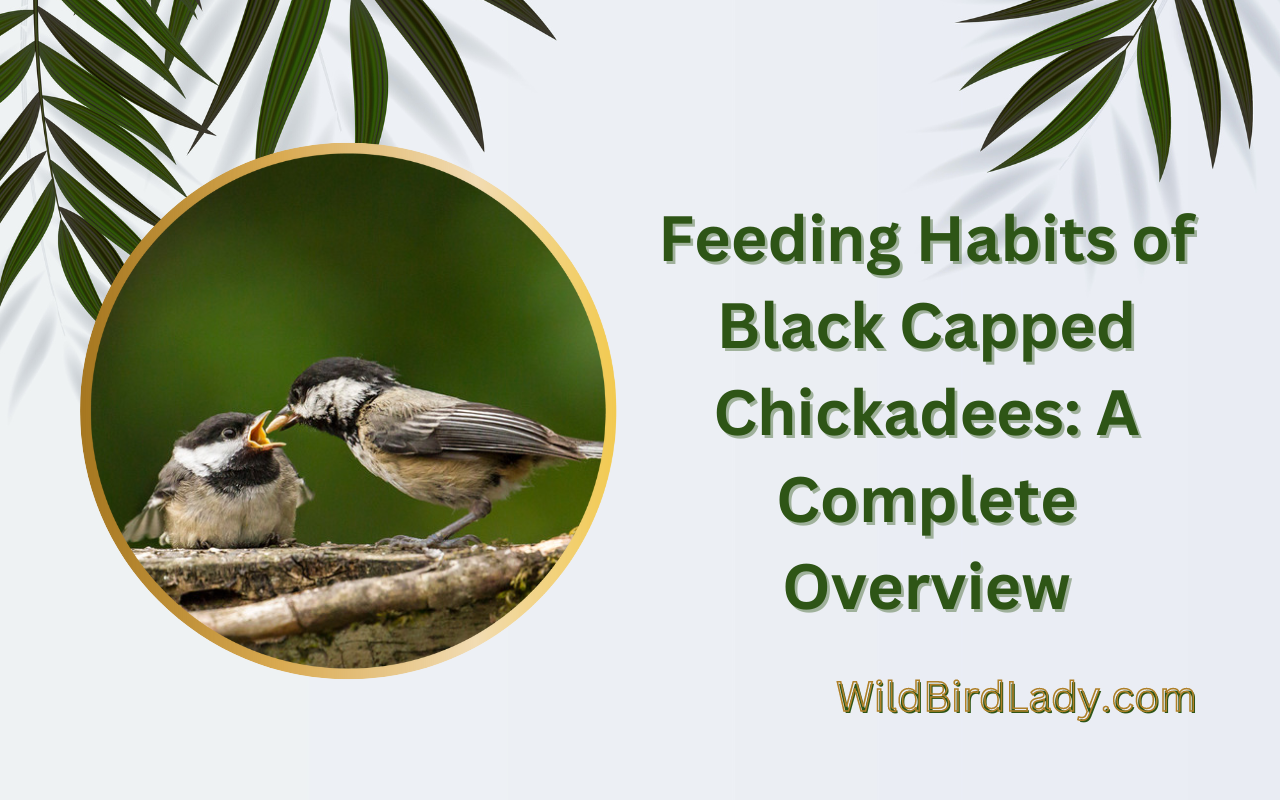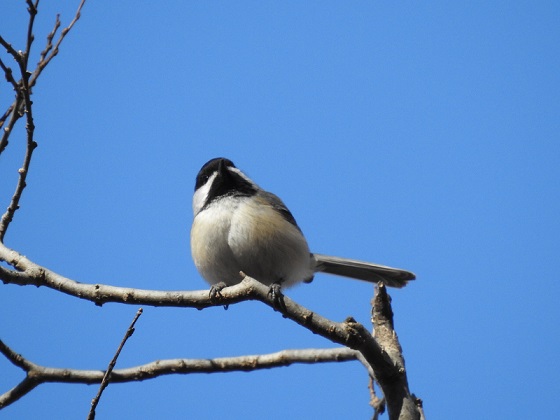Black-capped chickadees are omnivores and feed on a variety of insects, seeds, fruits, and berries. These birds are often seen foraging in mixed flocks with other small birds in the winter months.
Black-capped chickadees are small birds known for their distinctive black cap and bib, white cheeks, and gray wings and back. They are found throughout north america and are known for their acrobatic abilities and curious nature. These birds are omnivores and feed on a variety of insects, seeds, fruits, and berries.
Their feeding habits vary depending on the time of year and can include caching food, feeding from bird feeders, and foraging in mixed flocks with other small birds in the winter months. Understanding the feeding habits of black-capped chickadees can help create a welcoming environment for these charismatic birds in your yard or garden.
What Do Black Capped Chickadees Eat?
Black-capped chickadees are a small, lively bird species that inhabit north america’s boreal forests. They are known for their distinctive chick-a-dee-dee-dee call, and their ability to adapt and adjust to their surroundings. In this blog post, we will talk about their feeding habits, specifically, their food sources and the seasonal variation in their diet.
Natural Food Sources
Black-capped chickadees are primarily insectivores but have adopted an omnivorous diet to survive the harsh winter months. Insects such as caterpillars, spiders, and beetles make up a considerable portion of their diet, especially during spring and summer.
Apart from insects, chickadees also consume seeds and berries. They are known to seek out seeds from trees, such as conifers, birch, and alder, among others. They also enjoy eating sunflower seeds, and birds of this species are regular visitors to bird feeders throughout the year.
Artificial Food Sources
As mentioned above, black-capped chickadees are frequent visitors to bird feeders. They are known for their boldness and will visit feeders even when other larger birds are present. Sunflower seeds, shelled peanuts, and suet are among their favorite artificial food sources.
Seasonal Variations In Diet
Black-capped chickadees’ diet varies significantly during each season. In spring and summer, they rely heavily on insect-based protein for their nutrition. In autumn, they start to switch to seeds, berries, and nuts as they start to prepare for the winter.
During winter, their diet shifts to high fat and protein food sources such as suet, peanuts, and seeds.
Black-capped chickadees are fascinating birds that rely on a wide range of natural and artificial food sources to survive. Their food preferences and feeding habits vary depending on the season. As bird lovers, we can help to bring these beautiful birds to our backyards by providing them with a healthy and diverse diet suitable for their needs.
Foraging Behavior Of Black Capped Chickadees
Feeding Habits Of Black Capped Chickadees: A Complete Overview
Black-capped chickadee is a cute and tiny songbird that is native to north america. They have distinctive black caps with white cheeks that make them easy to recognize. These small birds are also known for their unique feeding habits that have captured the curiosity of bird enthusiasts for many years.
In this post, we will explore the interesting foraging behavior of black-capped chickadees, including the methods they use, the time they spend foraging, and their role in the ecosystem.
Methods Of Foraging
Black-capped chickadees use different methods for foraging, depending on the season and food availability. Some of the methods they use include:
- Gleaning: This is the most common foraging method used by chickadees. They search for insects and other small prey hidden in the bark of trees by inspecting crevices and cracks.
- Flycatching: Black-capped chickadees sometimes use flycatching as a foraging method. They chase flying insects such as moths, butterflies, and mosquitoes and catch them in mid-air.
- Hovering: Chickadees also use hovering as a foraging method. They hover over leaves, flowers, and branches to search for prey hidden in these areas.
- Seedbreaking: During the winter, black-capped chickadees mostly feed on seeds. They use their sharp and strong bills to break open seed pods.
Time Spent Foraging
Black-capped chickadees are active foragers and spend most of their day searching for food. They typically forage for five to six hours per day, but the duration may vary depending on the season and food availability. During the winter, chickadees spend more time foraging as they need to eat more to maintain their body temperature.
Role Of Black-Capped Chickadees In The Ecosystem
Black-capped chickadees play a crucial role in the ecosystem as they are important insect predators. They help control the population of insects that can be harmful to forests. Chickadees also feed on weed seeds, which helps control the growth of invasive plants in forests.
Additionally, black-capped chickadees are food sources for many predators, such as hawks, owls, and snakes, thus contributing to the food chain.
The foraging behavior of black-capped chickadees is fascinating, and these small birds are an essential part of the ecosystem. By understanding their feeding habits, we can appreciate their role in the environment and take measures to promote their conservation.
Black Capped Chickadees And Their Food Preferences
Black capped chickadees are small birds that feed on a wide range of foods, including insects, seeds, berries, and even small amphibians. They have unique feeding habits that vary according to different factors. We will explore the food preferences of black capped chickadees, considering the factors that influence their choices and their importance to survival.
Food Preferences Based On Age And Sex
The food preferences of black capped chickadees vary depending on their age and sex. Here are some key points to note:
- Adult chickadees have more diverse food preferences than young chickadees. Juvenile black capped chickadees typically prefer insects and arthropods.
- Male and female chickadees do not have different food preferences. However, some studies indicate that female chickadees have higher energy requirements due to breeding and may therefore have a stronger preference for high-energy foods.
Factors That Influence Food Preference
Various factors can determine the food preferences of black capped chickadees. Here are some of them:
- Availability: The availability of food is a critical factor in chickadees’ food preferences. They will often choose food that is abundant and easily accessible to them.
- Season: The time of year can also influence chickadees’ food preferences. During the breeding season, chickadees favor high-energy foods that help them maintain their energy reserves.
- Habitat: The habitat can also affect chickadees’ food choices. For instance, chickadees that live in coniferous forests are more likely to feed on conifer seeds, while those in deciduous forests prefer deciduous seeds.
- Predators: The presence of predators can also influence chickadees’ food choices. They tend to favor foods that reduce their risk of predation, such as hidden or camouflaged foods.
Role Of Food Preference In Survival
Food preference plays a critical role in the survival of black capped chickadees. Proper nutrition is vital for survival, especially during the harsh winter months. Here are some key points to note:
- Chickadees are known to store food in the fall to prepare for winter, so they have sufficient energy to survive the cold months.
- High-energy foods like seeds and suet can help chickadees maintain their body temperature, especially during extremely cold weather.
- Some studies indicate that proper nutrition can affect chickadees’ ability to evade predators, migrate, and reproduce successfully.
Understanding the food preferences of black capped chickadees can provide insights into their feeding habits. Food preference depends on different factors, including age, sex, availability, season, habitat, and predators. Proper nutrition is critical to the survival of chickadees, especially during the winter season.
By considering these factors, bird enthusiasts can create suitable habitats and provide the appropriate food sources to these fascinating birds.
Conservation Of Black Capped Chickadees
Black capped chickadees are small, non-migratory, and active birds found in north america. They are known for their acrobatic feeding habits and distinctive vocalization. These birds are found in wooded areas and prefer coniferous forests with a large number of trees.
Threats To Black Capped Chickadees
Like many other wildlife species, black capped chickadees face a variety of threats, including:
- Habitat loss due to deforestation and climate change
- Predators such as cats, snakes, and raptors
- Competition from invasive bird species for nesting sites and food
- Pesticides affecting the availability and quality of their food sources
Measures To Conserve Black Capped Chickadees
Several measures can be implemented to conserve black capped chickadees:
- Protecting and expanding their habitat by conserving natural areas, promoting reforestation, and limiting deforestation
- Install nest boxes to counter the loss of natural nesting sites
- Implement measures to control predators, including the use of bird-safe cat collars, snake fences, and habitat modification for predators such as raptors
- Promote the use of bird-friendly pesticides and herbicides
Role Of Humans In Conserving Black Capped Chickadees
Humans play a significant role in conserving black capped chickadees. Here are some ways in which they can help:
- Reduce carbon footprint to reduce the impact of climate change on their habitat
- Create backyard habitats by planting trees, shrubs, and native plants that provide food and shelter
- Participate in citizen science programs that focus on monitoring black capped chickadee populations and habitat
- Avoid using pesticides and herbicides that are harmful to black capped chickadees
Overall, conservation efforts for black capped chickadees should focus on improving their habitat and reducing negative human impacts. With collaborative effort, these efforts can help protect these small birds and their characteristic feeding habits for generations to come.
Frequently Asked Questions Of Feeding Habits Of Black Capped Chickadees: A Complete Overview
What Do Black-Capped Chickadees Eat In Winter?
Black-capped chickadees feed on insects, seeds, and berries in winter. They cache food items in tree cavities, and remembering the location, retrieve food when they need it.
How Often Do Black-Capped Chickadees Eat?
Black-capped chickadees have high metabolisms, so they eat frequently throughout the day. They eat about 35% of their body weight per day.
How Do Black-Capped Chickadees Find Food?
Black-capped chickadees use a combination of sight and sound to locate food. They also have excellent memories and can remember the location of food sources.
Do Black-Capped Chickadees Eat From Bird Feeders?
Yes, black-capped chickadees eat from bird feeders. They prefer sunflower seeds, mealworms, and peanuts, but also consume suet, cracked corn, and nyjer.
What Is The Average Lifespan Of A Black-Capped Chickadee?
The average lifespan of a black-capped chickadee is around 2-3 years in the wild, but they can live up to 10 years in captivity.
Conclusion
Feeding habits of black-capped chickadees are fascinating to study, and we can learn a lot from these tiny birds. They are efficient foragers and can survive in harsh weather conditions due to their remarkable ability to store food. Black-capped chickadees use a variety of skills to search, capture, and process their food.
Attracting these birds to your garden is not only beneficial to them, but it can also bring some joy to your surroundings. By offering a variety of natural food sources and providing feeding stations at the appropriate times, you can help maintain their population and enjoy watching them interact with each other.
Understanding their feeding habits is crucial to maintaining a healthy environment for them and other wildlife. Therefore, it is essential to protect their natural habitats and maintain a balance in our ecosystem, so we can continue to enjoy the beauty of these amazing birds.
Published on June 3, 2023 | Last Updated on June 27, 2025 by Rifat Ahmed
Latest Posts
By Rifat Ahmed – Birdwatching Expert (13+ Years of Experience) If you've ever startled a quail in the wild, you've probably witnessed it explode into flight with a surprising burst of...
How Long Do Quails Live? Tips to Help Them Live Longer and Healthier Lives
By Rifat Ahmed – Birdwatching Expert with 13 Years of Experience As someone who has spent over a decade watching quails flutter through grasslands and woodland edges, I've often been asked: how...



